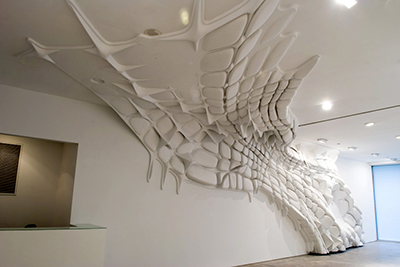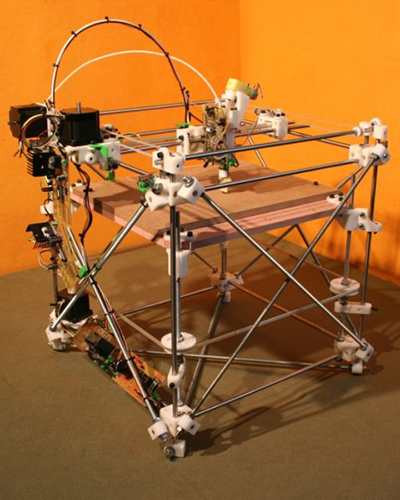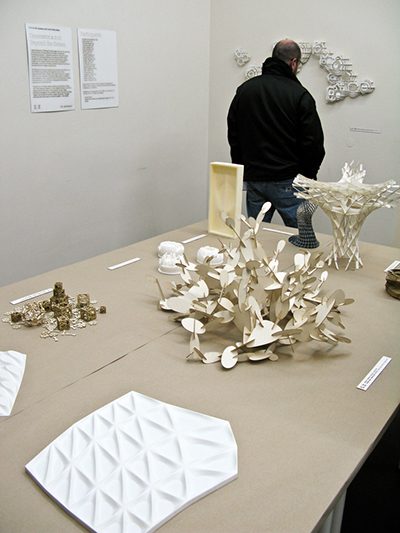
Several years ago, while making the lecture circuit rounds, American architect William Massie described a key goal within his practice as moving towards a more direct translation between bits and atoms. Architecture has always thrived on the tension between representation and material assemblages and what he was addressing with this comment was the dawning of an era characterized by a new proximity between digital models and physical output. In selected contexts, artists, architects, and designers have been exploring these accelerated development cycles for a decade but the involved technologies are descending in price so quickly that, for example, 3D printers are now cheaper than laser printers were in 1985. A key question: how does the looming ubiquity of these tools and workflows apply to the production and display of new media art? This article will explore digital fabrication (aka fabbing) at a variety of scales which include the curatorial questions raised by these new hybrid industrial design/sculpture objects as well as the implications on the practice of individual artists. Before delving into either of these milieus it would be useful to acknowledge some common language and terminology associated with fabrication and recognize some important precedents.
Wikipedia defines rapid prototyping as the "automatic construction of physical objects using solid freeform fabrication." Solid freeform fabrication is an umbrella term for a range of (often proprietary) techniques which include extrusion, sintering, curing and printing. So when we use the term "rapid prototyping" we are referring to some variant of the aforementioned 3D desktop printer. Another important process to consider is Computer Numerical Control (CNC) in which a geometrical form, as defined by a 2D or 3D CAD drawing, is translated into a tool path and cut out of an existing object or laminate. Common forms of CNC include milling and laser cutting. CNC is not new, one need only venture to their nearest signage shop to prove this point, but, like 3D printing, CNC technologies are going through a process of rapid miniaturization and are becoming affordable to individuals outside industry.
Let's be clear, the fundamentals driving many of the processes on the above laundry list of production techniques are old hat in sculpture. What is noteworthy is that these methods (complex mold making, subtractive techniques, etc.) are becoming less esoteric, increasing in precision and affordability and, in certain instances, being developed with an open source mandate. A great example of where homebrew fabrication could be headed (at least for the microcontroller savvy) is the RepRap project.

Launched in 2004, RepRap aspires to deliver a "self replicating rapid prototyper" which can reproduce many of its own parts. Originally proposed and developed by Adrian Bowyer, RepRap is now being researched and refined by a team of globally distributed collaborators. The one-sheet for the project reads like a call to arms for personal manufacturing and points out that (almost) everyone in the developed world "...runs their own printing works, their own photographic laboratory, and their own CD-pressing plant. Moving from two-dimensions to three, why shouldn't they make their own MP3-players, their own coat hooks, and their own car wing mirrors?" Rob Myers reblogged the original RepRap news coverage on Rhizome in June 2005 and wisely added "Now make art with it." While this endeavor represents a "blue sky" means of desktop-production, and becomes more plausible and technically proficient by the month, an entire generation of artists and designers are already exploring more conventional means of fabrication and CNC. The easiest way to get a sense of the range of work being done is to scan a few shows from the last year and then ponder the ramifications for artists and curators.
The 2008 edition of "C.STEM" was described with the genetics-meets-design tagline of "breeding objects". The show was decidedly multidisciplinary and brought together a range of work which included Ammar Eloueini's CoReFab#116 , Ebru Kurbak and Mahir Yavuz's News Knitter, IVY by MOS, the aforementioned RepRap project and many others. In essence, the show was a celebration of process and the artifacts on display were augmented with video, models, diagrams and even props to help situate them in the natural environments in which they might be encountered. The exhibition statement described contemporary praxis as usurping the mass produced "all-of-a kind object" with "families of unique and one-time products" characterized by parametricism and driven by flexible, generative systems. The motley crue of participants were assembled under the umbrella title of "post industrial designers," a terminology that suggested a reexamination of craft with a nod towards the critical theory crowd.

2008 also marked the launch of "Generator.x 2.0: Beyond the Screen," an expansion of Marius Watz's generative art curatorial platform to explore algorithmic design within the arena of digital fabrication. Organized as a workshop and subsequent exhibition at [DAM] Berlin (as part of Club Transmediale 2008), the initiative showcased a range of experimental prototypes, many of which were produced in a charrette environment. Work featured included Theverymany's Aperiodic_Vertebrae, Jared Tarbell's Spheroids and Cubes, David Dessen's Foldable Fractal, Watz's Object 1-3 and about a dozen other projects. When asked about the goals of this new iteration of "Generator.x" Watz is quick to identify a desire to dispel the myth that generative art is simply the production of "screensavers". He continues, "digital fabrication allows for a software-based approach to physical production, meaning that computational processes can be used in all parts of the production. It's an ironic reversal of the last decade's transition towards the digital." Read in this light, exhibitions like "Beyond the Screen" and "C.STEM - Breeding Objects" represent a convergence of code and craft, whereby experiments in geometry and data manipulation are considered as the basis for systems of assembly and material expression.
In her 2009 predictions for The L Magazine, Paddy Johnson cynically labeled 3D printing the "new Photoshop." Johnson forecasted a "remarkably bad but ultimately short lived art-making fad exploring little more than what the technology does." While dismissive, Johnson's caution is not entirely unwarranted as a 1:1 translation of technocratic architecture school machinations into gallery space will not appeal to a wide audience. However, these tools and workflows are only going to become more predominant in all arenas of production, artistic or otherwise - perhaps what we'll see is an initial manic investigation of possibility followed by more nuanced considerations of construction and volume. Also, see Gareth Long's Video Solid (2006) as an example of how fabbing might interface with more familiar media art practices. The problem with Johnson's skepticism is that it fails to acknowledge the complexity and potential of fabrication. Really though, how can anyone who is interested in the algorithm as a tool for expression not be captivated by this work extending into space - digital artists finally have the opportunity to generate their own "hello world" objects.
If this is indeed an era of software studies it only follows that engaging or creating custom software environments might have material repercussions. Design and speculative fiction provocateur Bruce Sterling identifies the generative means of production as the key issue within fabbing. He states "generative art and design are alien to all conventional creative methods - it challenges them in the way that a kaleidoscope challenges a telescope." Perhaps in framing this emerging access to immediate means of production it would be most useful to return to the notion of the post industrial designer offered at "C.STEM - Breeding Objects." If this new creative class blurs the line between artist and industrial designer as well as code and artifact it only follows that the manner in which we exhibit and consider this work will require rethinking as well. If galleries are going to be increasingly populated with arrays of fabricated artifacts, what will the tone and context of these exhibitions be? Fantastical product launches? Featured objects with extensive accompanying media to document process? Or "business as usual" strategies for sculptural display? Time will tell.
Greg J. Smith is a Toronto-based designer and researcher. Greg co-curates and edits the digital arts publication Vague Terrain and blogs at Serial Consign.


I actually hadn't meant to issue a whole scale dismissal of artist's use of the technology, though I can see how my prediction might have read as such. I've seen a lot of great art work made with 3-D printing machines, it just seems like there's a school of market artists out there interested in novelty over anything else.
Hi Paddy,
I just used the comment as a springboard into discussing general skepticism towards the field. I understand the "Gee Whiz" kind of Photoshop filter work you were referring to, and that sentiment might not necessarily lead to interesting artifacts in fabrication. What excites me so much is seeing people working with code suddenly thinking about tectonics, joinery and assembly. I'd love to see an Art Fag City post at some point highlighting some of the good fabbed work you've seen. :)
Closely related to the RapRap project, you might also want to take a look at the Fablab Network, a concept that has been growing over the last few years. Initially started by Neil Gershenfeld's class "How to Make Almost Anything" at the MIT Meida Lab, Fablabs provide places where engineers, inventors, designers and artists can come and work hands-on with fabrication technlogy.
I've been working in the Fablab Amsterdam for the last year, in lot of ways we're still in the "hello world" stage when it comes to working with these tools but it's still exciting to see artists embracing the technology. Oftentimes they're using the same skills that were once only used for creating print and screen works, now to create their first physical artworks.
I was getting heckled on twitter for not mentioning the Fablab Network! I do think it is a brilliant project.. somewhere I read it described as a middle ground between Commercial applications and RepRap. I like RepRap as an endgame for artists as it means, a cheap printer or mini-mill on the desktop. My understanding (and please correct me if I'm wrong) is that the FabLab project is kind of a distributed research initiative with goals to function as kind of a fabbing OLPC in certain countries. What exactly are you producing in Amsterdam?
I think the c.stem 2008 offered a glance on the potential of fabbing (fabbing seems to be the buzzing umbrella term for all the additive and subtractive production methods these days…) for media art as well as industrial/commercial application. It's a pitty that lots of "mainstream media" (with mainstream I do not (yet) refer to mainstream mainstream but the big blogs and trendsetting magazines…) praising the wonders of 3d printing & Co TECHNOLOGY (actually they only praise 3d printing…). But to be true: Haven't been the technologies as such (3d printing, cnc,…) already been around for "some" years? ok, we have seen giant drops in prices and a gigantic increases of quality the last few years (thanks to projects like fab@home, Fab Labs, RepRap…).
The real hot and breathtaking thing will be the application of all these technologies (as coined as a key question at the beginning of these article).
My Media and Communications background always let's me compare fabbing with the invention of Gutenberg's printing machine… It won't take a long time and the hype about the technology (which is indeed a wunderful enabler for great ideas to become reality) will cool dawn. When I am thinking of Gutenberg and the erruption following the invention of his machine which changed the whole world by democratizing (step by step) knowledge…wow, I am really looking forward to know who will be the Goethe, Shakespeare or Tolkien of fabbing…
I participated in the generator.x2.0-workshop. It was a very mixed crowd of designers and architects. Having these new and exciting possibilities available is amazing, but also very very challenging. I started with the most simple thing i could come up with and it really was my "hello world". and even that was tricky to make it work. It was obvious that the architects are better at this, while the artists had a different approach to material and structure. Both, the professional approach to deal with 3d and the "naive" artistic approach lead to interesting results. I personally don't really see all the outcome as works of art, while some definitely is. To me this really feels like touching a pencil for the first time. But I'd say it's way more than the next photoshop. For now, the distance form Gutenberg to Photoshop seems smaller to me than what we got with generative strategies and digital fabrication.
Maybe some day I'll be able to express my artistic intention in 3d, to get there I am very interested to get into this asap. Yes, we're after the new stuff. Because it's new, but also because it's so much more than the flat layer we've been trapped in for so long. It's like suddenly growing your prints into space, pretty wow. But honestly, along the way from idea to code to form, there also happens a lot of not so arty stuff. Like when you give your kids a box of new markers and leave them alone in your house for a couple of hours. Who would have thought that ?
This point was very well translated into the title "beyond the screen", it's exactly that for now. So, while the architects are not sooo hyped anymore about yesterdays next big thing, most of the artists are still laughing manically while pumping out generated form into physical space…
"Because it's new, but also because it's so much more than the flat layer we've been trapped in for so long. It's like suddenly growing your prints into space…"
This follows the notion of Malevich's concept of the "additional element" in his Suprematist manifesto back towards the beginning of the 1900's. There is certainly an excitement in having a recent additional element (or perhaps a digital equivalent of past elements) added to the methods by which one can make creative work.
I would like to respond to the comments on the notion of artists pursuing novelty over anything else with two quotes.
The philosopher Susanne Langer wrote in her book Mind: An Essay on Human Feeling, "The real patterns of feeling… how daydreaming weaves in and out of realistic thought, how the feeling of a place, a time of day, an ordinary situation is built up–these felt events, which compose the fabric of mental life, usually pass unobserved, unrecorded and therefore essentially unknown to the average person…They pass unrecorded because they are known without any symbolic mediation, and therefore without conceptual form. We usually have no objectifying images of such experiences to recall and recognize…" (Langer 24).
Nicolas Bourriaud in his book Postproduction (2002) states: "…how can we produce singularity and meaning from this chaotic mass of objects, names, and references that constitutes our daily life? Artists today program forms more than they compose them: rather than transfigure a raw element (blank canvas, clay, etc.), they remix available forms and make use of data" (Bourriaud 17).
Digital fabrication is yet another tool within the artist's tool bag to symbolically mediate the patterns of human feeling. It is particularly useful in response to human feeling in relation to notions of time, memory, and perception.
Ed
http://www.flickr.com/edwardsjohnston
http://www.edwardsjohnston.com
http://www.youtube.com/edwardsjohnston
Great design, nice ideas,
Thx for sharing.
London house extensions
More than the resulting object itself, it's the relationship to design (generative or otherwise) and production of meaning, that is the most interesting part of fabbing. The object almost becomes incidental to the artistic process, and no longer the artistic object itself…
To flog the Photoshop analogy further: The relationship to, and knowledge of, image manipulation — even among people who aren't very good at it or use it professionally — has altered the public understanding of photographic images as well as calloused us to works that previously would be considered more impressive. Rapid manufacturing might shift the attention from "ooh, shiny computer assisted DIY produced thing" to "well yeah, but why are you producing that thing?"
Thanks for an interesting article!
Mateusz | http://monocultured.com/blog